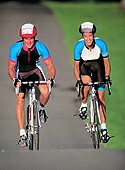- Skip Storing This Everyday Product in the Fridge Door
- Green Tea + B3 Pairing May Boost Brain Health
- Navigating Your Midlife Crisis: Embracing New Possibilities
- City Raccoons Showing Signs of Domestication
- Mapping the Exposome: Science Broadens Focus to Environmental Disease Triggers
- One Week Less on Social Media Linked to Better Mental Health
- Your Brain Changes in Stages as You Age, Study Finds
- Some Suicide Victims Show No Typical Warning Signs, Study Finds
- ByHeart Formula Faces Lawsuits After Babies Sickened With Botulism
- Switch to Vegan Diet Could Cut Your Greenhouse Gas Emissions in Half
Education Linked to Activity Levels During the Week


College-educated Americans tend to be more physically active on weekends, while adults without a high school diploma are more active on weekdays, a new study finds.
Researchers analyzed data from the 2005-2006 U.S. National Health and Nutrition Examination Survey and found that people with a college degree were inactive an average of 8.72 hours a day on weekdays, compared with 7.48 hours for people without a high school diploma.
On weekends, people with a college degree were inactive an average of 8.12 hours per day, compared with 7.86 hours per day for people without a high school diploma, according to the study scheduled for presentation Tuesday at the annual meeting of the American Sociological Association in San Francisco.
These patterns came as no surprise because previous research has found that people with lower levels of education tend to be more physically active at their jobs during the week, said study lead author Jarron Saint Onge, an assistant professor of sociology at the University of Kansas.
However, that work-related activity tends to be low intensity and typically involves repetitive motions that can have harmful health effects, Saint Onge noted.
Study co-author Kyle Chapman, a doctoral candidate in sociology at the University of Kansas, pointed out that “education affects people both at the individual level and at their social level. Physical activity is encouraged or discouraged in different groups,” he said in an association news release.
The study findings could be used to develop public health programs to increase physical activity based on people’s education levels, he suggested.
“You have to be flexible. We have to give people different ideas. We have to have discussions on what works for some and what works for others,” Chapman said.
Data and conclusions presented at meetings are typically considered preliminary until published in a peer-reviewed medical journal.
More information
The U.S. National Institute of Diabetes and Digestive and Kidney Diseases offers tips to help you get active.
Source: HealthDay
Copyright © 2025 HealthDay. All rights reserved.










